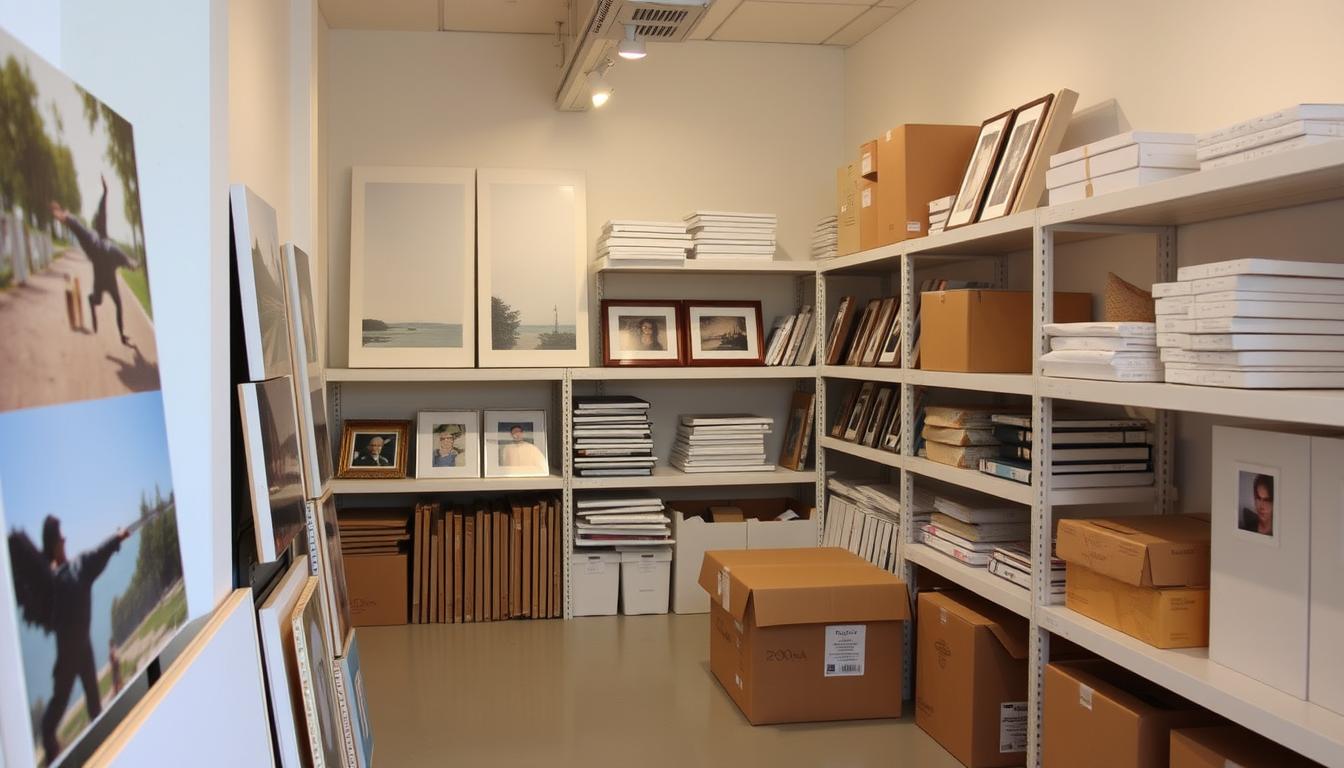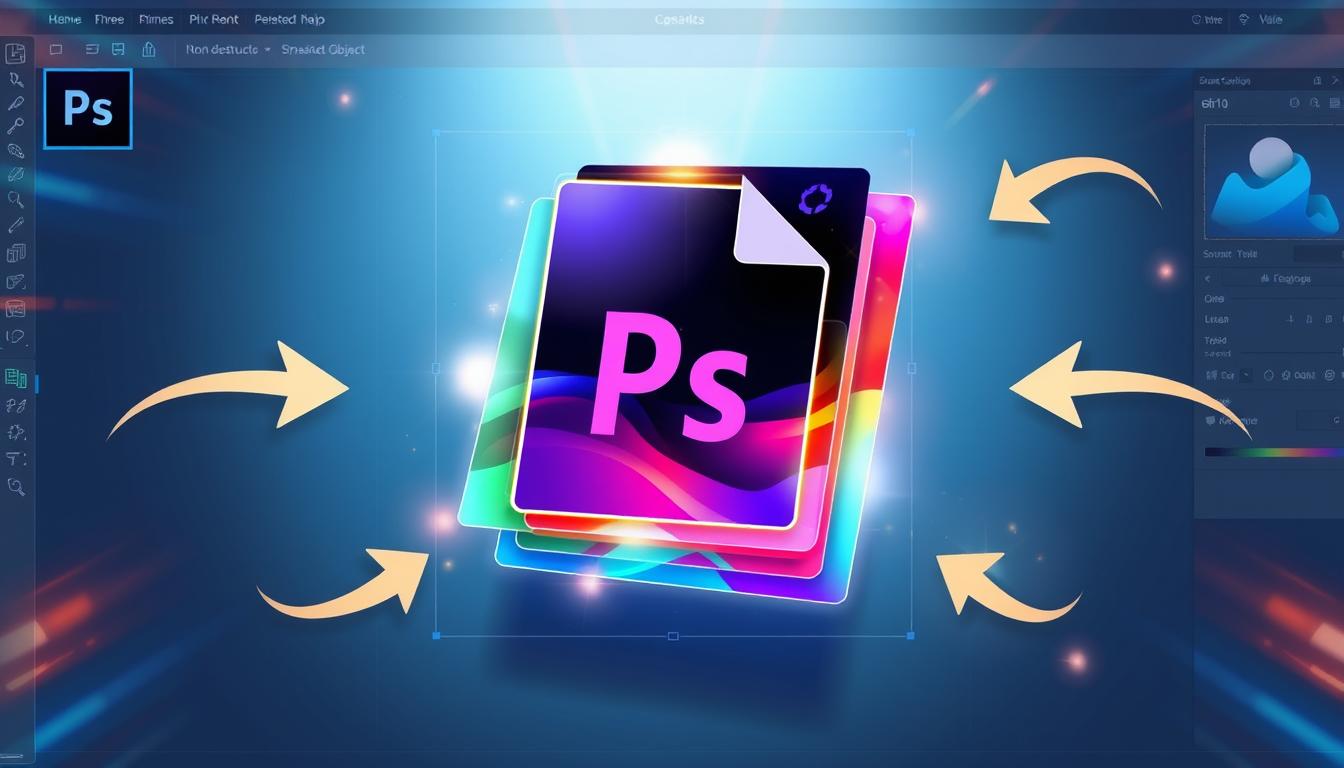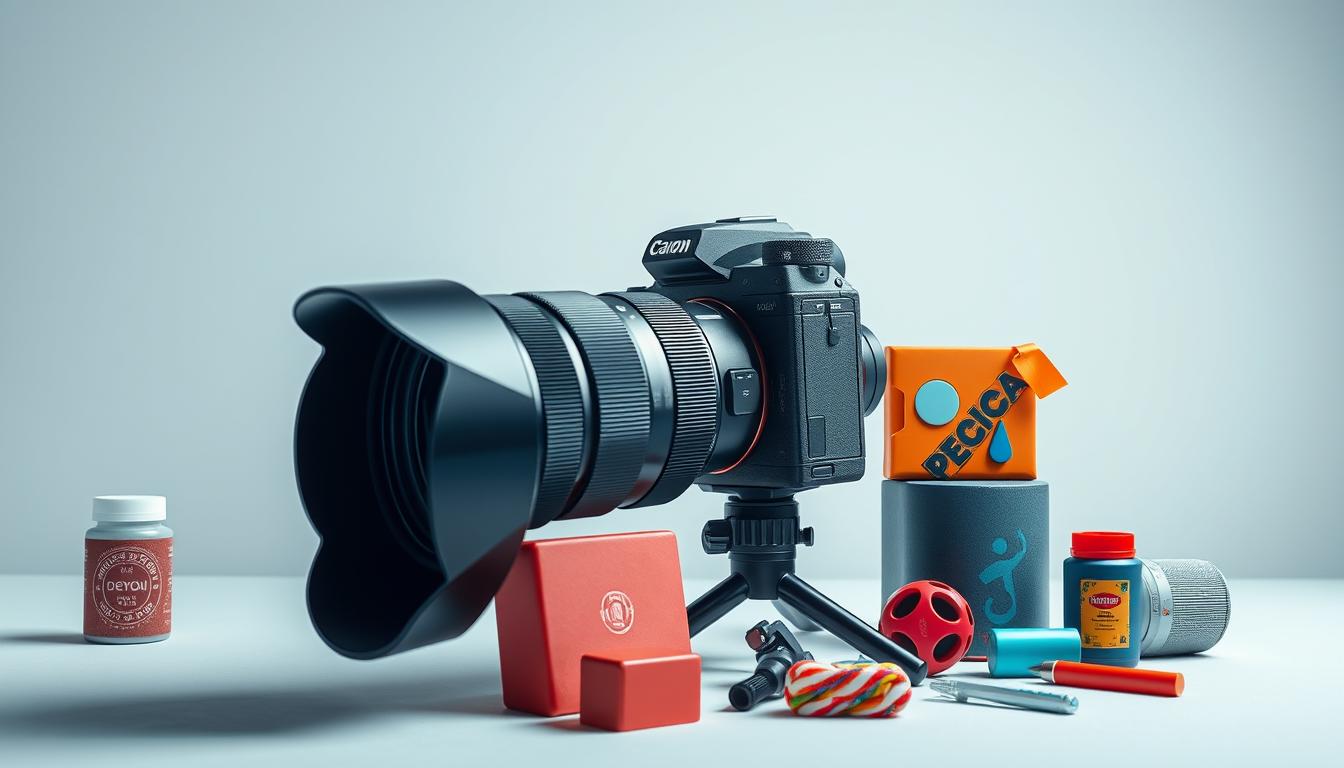As an artist or photographer, you put your heart into every piece. Your artwork and photos are more than files; they’re a part of you. They show your unique vision and creativity. But have you thought about how you store these digital treasures? Are they safe and easy to find when you need them?
In today’s world, keeping your files organized is key. Losing your work due to a computer crash or accidental deletion is a risk. That’s why online storage is important. Cloud storage for your artwork and photo archiving can protect your creations. It makes sure your work is safe and ready for you whenever you need it.
This article will show you the top online spots to store your artwork and photos. We’ll look at cloud storage like Google Drive, Dropbox, and iCloud. We’ll also check out platforms made for creatives, such as DeviantArt, Flickr, and 500px. Plus, we’ll talk about the benefits of an online portfolio with storage. It’s a great way to show off your work while keeping it safe.
Importance of Storing Your Photography Securely
As an artist or photographer, your work is more than just files or prints. It shows your passion, skills, and hard work. That’s why keeping your artwork preservation and secure art storage safe is key.
In today’s world, digital asset management is vital for creatives. Storing your work online securely protects it from loss or damage. It also makes it easy to share and show your talent worldwide.
By choosing reliable online storage, you can rest easy knowing your work is safe. We’ll look at different ways to store your creative assets online. This includes cloud storage and platforms made for artists and photographers.
Cloud Storage Solutions for Artists and Photographers
Artists and photographers need a safe place to store their digital work. Cloud storage is a great option. It keeps your files safe and lets you access them from anywhere. Let’s look at some top cloud storage options for creatives.
Google Drive for Storing Your Artwork and Photos
Google Drive offers 15GB of free storage. It’s reliable, simple, and compatible with all of Google’s other apps.
- Organize your artwork and photos into folders and subfolders
- Access your files from any device with a web browser or the Google Drive app
- Collaborate with others by sharing files or folders
Dropbox: A Reliable Option for Creatives
Dropbox is a trusted cloud storage service for creatives. It offers:
- 2GB of free storage space, with options to upgrade for more
- Automatic syncing across devices, ensuring your files are always up to date
iCloud for Apple Users
iCloud is great for Apple users. It makes it easy to store and access your photos and artwork. Here are some key features:
| Feature | Benefit |
|---|---|
| 5GB of free storage | Ample space for storing artwork and photos |
| iCloud Photos | Automatically syncs your photos across all your Apple devices |
| Integration with Apple apps | Easily access your files from apps like Photos, Pages, and Keynote |
When picking cloud storage, think about storage space, ease of use, and device compatibility. Google Drive, Dropbox, and iCloud are good choices. Cloud storage is a secure and easy way to store and organize your creative work.
Dedicated Online Platforms for Artwork and Photography Storage
If you’re an artist or photographer, you might want a special place to store and show your work. Online photo galleries and virtual art portfolios are perfect for this. They have features made just for you and a community that supports your art. Let’s look at some top choices for storing and displaying your digital art.
DeviantArt: A Community-Driven Platform for Artists
DeviantArt is a top site for artists of all levels and styles. It’s easy to use and has great storage for your art. The community is active, offering feedback and inspiration. It’s great for artists who want to meet others who share their passion.
Flickr: A Popular Choice for Photographers
Flickr is a favorite among photographers for storing and sharing photos. It has lots of storage and makes organizing easy. You can also connect with other photographers, join groups, and take part in challenges.
500px: A Professional Photography Platform
500px is for professional photographers and serious hobbyists. It has a modern look and advanced tools for showcasing your work. The community is focused on quality, making it a good place to show your best photos and meet clients.
When picking a platform for your art or photos, think about storage, organization, community, and look. Choose one that fits your needs and goals. This way, you can create a standout online gallery or portfolio that shows off your talent and draws in the right people.
Creating an Online Portfolio with Built-In Storage
As an artist or photographer, it’s key to show your work well to attract clients and chances. A virtual art portfolio or online photo gallery is perfect for this. It lets you display your best work and manage your digital assets easily. Behance and Carbonmade are two top platforms for this.
Behance: Showcase Your Work and Store It Too
Behance, owned by Adobe, is a top spot for creatives. You can upload your work, organize it, and share it worldwide. It also has built-in storage for your files.

Behance stands out for its Adobe product integration. This makes importing your work easy. It also tracks your portfolio’s success and lets you connect with viewers.
Carbonmade: A Sleek Portfolio Platform with Storage Options
Carbonmade is great for artists and photographers wanting a sleek portfolio. It’s easy to use and has customizable templates. It offers storage plans to fit your needs.
Carbonmade is known for its simplicity. It helps you create a clean portfolio that focuses on your work. You can organize projects, add descriptions, and even create private galleries.
When picking between Behance and Carbonmade, think about what you need. Both offer great storage and ways to showcase your work. They’re great for artists and photographers wanting to manage their digital assets online.
Where Can I Store Photography Pictures? Exploring the Options
There are many places to store your digital art and photos. Each has its own special features. It’s important to think about what you need before choosing a place to store your work.
There are also special sites for artists and photographers. For example:
- DeviantArt: A community-driven platform that allows you to showcase and store your artwork
- Flickr: A popular choice for photographers, offering free and paid storage options
- 500px: A professional photography platform with built-in storage and portfolio features
When picking a place to store your art and photos, think about a few things. Look at how much storage you get, how much it costs, and how easy it is to use. Also, think about any extra features that might help your creative work.
The best place to store your art and photos is one that fits your needs. It should keep your work safe and easy to find.
Tips for Organizing Your Digital Art and Photo Files
If you’re an artist or photographer, you have lots of digital files to manage. A few strategies can help you keep your files in order. This way, your work is easy to find when you need it. Here are some tips to organize your digital art and photos well.
Creating a Consistent Naming Convention
Setting up a consistent naming system is key for managing digital assets. A good naming system helps you quickly find images and understand what they are. Include the date, project name, subject, and version number in your file names. For example:
Using Folders and Subfolders for Easy Navigation
Organizing your files in folders and subfolders is crucial. Create a structure that fits your workflow and projects. For example, you might have folders for each year, with subfolders for clients, projects, or themes.
Tagging Your Files with Relevant Keywords
Tagging your files with relevant keywords also helps in managing your images. Most digital asset management software lets you add metadata, including tags or keywords. This way, you can quickly find images based on their content, style, or purpose. It saves you time and effort.
By following these tips, you’ll have a system that makes your workflow smoother. Your creative work will always be ready when you need it.
Backup Strategies to Protect Your Artwork and Photographs
As an artist or photographer, keeping your work safe is key for artwork preservation. Good backup plans help keep your digital work safe from things like hardware failure or data loss.
The 3-2-1 backup rule is a top choice for keeping your work safe. It means having three copies of your data, on two different kinds of media, with one copy away from your main location. This rule helps protect your work from disasters or tech problems.
3-2-1 Backup Rule: A Best Practice for Creatives
To follow the 3-2-1 backup rule, here’s what to do:
- Keep your main copy on your computer or an external hard drive.
- Make a second backup on a different kind of storage, like another hard drive or cloud storage.
- Have a third copy somewhere else, either in a physical place or in a cloud-based digital asset management system.
Automating Your Backup Process
To make sure your backups are always done right, think about automating them. Many cloud services and backup software let you set up automatic backups.
With a solid backup plan and automated backups, you can be sure your work is safe. This lets you focus on your art without worry.
Printing and Physical Storage Options for Your Photos
Digital artwork preservation and secure art storage are key. But having physical copies of your work is also vital. Printing your art and photos gives you tangible backups that last long. Let’s look at some ways to print and store your physical art.

Many artists and photographers choose professional printing services. These services provide top-notch prints on materials like canvas, fine art paper, or metal. When picking a service, look at color accuracy, paper quality, and protective coatings. Online printing services also offer photo archiving options for organizing your prints.
For printing at home, get a good printer and use archival-grade paper and inks. These materials help your prints stay bright and true to color over time. Store your prints in acid-free boxes or portfolios to keep them safe from dust, moisture, and light.
For secure art storage, consider a climate-controlled storage facility. These places keep the temperature and humidity just right to protect your art. Look for a storage unit made for art and photography, with UV protection and fire systems.
Organize your physical art and photo collection with a labeling system. Include the title, date, medium, and other important details. This makes managing your collection easier and helps with artwork preservation over time.
Conclusion
Keeping your artwork and photography safe is key to protecting your legacy. Online platforms and storage solutions help keep your digital art and photos safe. Cloud services like Google Drive, Dropbox, and iCloud are great for storing and backing up your files.
Platforms like DeviantArt, Flickr, and 500px offer spaces to showcase and archive your work. They have a community feel. An online portfolio with built-in storage, like Behance or Carbonmade, lets you display your work while keeping it organized.
For digital art and photo storage, use a consistent naming system. Organize files with folders and subfolders. Tagging files with keywords makes them easier to find.
Protect your work by using backup strategies like the 3-2-1 rule. Automate your backups to keep your files safe. Storing files in the cloud and on physical drives reduces data loss risk.
By taking steps to store and organize your work, you ensure it lasts for generations. This way, your artistic vision can be enjoyed by many in the future.
FAQ: Online Storage for Artwork & Photography
What are the best online platforms for storing artwork and photography?
The best platforms for storing artwork and photos are Google Drive, Dropbox, iCloud, DeviantArt, Flickr, and 500px. These platforms offer secure storage, easy access, and tools made for artists and photographers.
Why is it important to store my artwork and photography securely online?
Secure online storage protects your work from loss, damage, or hardware failure. It also makes your files easy to access, share, and organize from any device, ensuring your creative work stays safe long-term.
What cloud storage solutions do artists and photographers use most?
Google Drive, Dropbox, and iCloud are the most popular options. They provide large storage space, simple file management, and seamless syncing across devices, making them ideal for storing high-resolution photos and artwork.
Are there platforms made specifically for storing artwork and photography?
Yes. DeviantArt, Flickr, and 500px are built for artists and photographers. They allow you to store, organize, display, and share your work within a creative community.
Can I build an online portfolio that also stores my artwork and photography?
Yes. Platforms like Behance, Adobe Portfolio, and Carbonmade let you create an online portfolio with built-in storage. They make it easy to showcase your work and keep everything in one place.
What’s the best way to organize digital art and photo files?
Use a clear naming system, create folders by project or client, and add tags or keywords to each file. This makes your library easy to search and helps you find your work quickly.
How can I keep my artwork and photos safe for the long term?
Follow the 3-2-1 backup rule:
Keep three copies of your files
Store them on two different types of storage
Keep one copy off-site or in the cloud
Setting up automatic backups ensures your work stays protected without manual effort.




